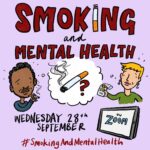Introduction
Anxiety is something we can all relate to. For the most part, anxiety represents a healthy and adaptive physiological response to feared stimuli, preparing your body to respond accordingly. Perfect if you are being chased by a bear. However, it can be problematic if those feared stimuli are benign, no longer present, or constitute persistent worries about the future.
At its most debilitating, anxiety can be classified into a range of psychiatric diagnoses. The most common of these is generalised anxiety disorder (GAD), which has an estimated lifetime prevalence in the UK of between 4-7%. GAD is characterised by a range of physical symptoms such as muscle tension, poor concentration and disturbed sleep, as well as psychological symptoms such as ongoing and uncontrollable worry. Diagnoses such as panic disorder, social anxiety disorder and phobias all feature anxiety as a primary symptom. In total, anxiety-related difficulties have been estimated to affect as many as 18% of a US-based adult population over a 12-month period.
Though previously categorised as anxiety disorders, both obsessive compulsive disorder (OCD) and post-traumatic stress disorder (PTSD) are increasingly being understood as separate diagnoses, but again with anxiety as a common symptom.
What we know already
People with long-term physical health conditions are more prone to experience anxiety as a result. For example, it is estimated that people with Chronic Obstructive Pulmonary Disease (COPD) are up to 10 times more likely to receive a diagnosis of panic disorder than the general population. This, in turn, has considerable implications on healthcare expenditure.
Psychological treatments such a cognitive-behavioural therapy (CBT) have been widely researched and shown to be effective across a range of anxiety disorders. In the case of specific phobias, these techniques can elicit significant improvement in just one session. However, improvement rates are lower across other anxiety disorders.
In England, the National Institute for Health and Care Excellence (NICE) recommends CBT as the first line treatment of anxiety disorders. Pharmacotherapy, such as Sertraline, can also be beneficial, and is recommended as an adjunct to CBT where the person’Âs difficulties are more severe.
Areas of uncertainty
Anxiety has been conceptualised in many ways, which in many ways have shaped the range of treatments available. This proliferation of cognitive, developmental, information-processing, neurochemical and other models of understanding anxiety can create a confusing picture. Similarly, whilst there is a clear hereditary component to anxiety, the precise nature is not yet clear.
Whilst psychological and pharmacological treatments can be effective for many, there is still work to be done in identifying the mechanisms of change and improving outcomes.
What’s in the pipeline?
Historically, research into anxiety disorders focused more heavily on adult populations. However, with the recent emergence of disciplines such as paediatric psychology, there is a greater emphasis on tackling anxiety difficulties at a younger age.
As our understanding of genetics improves, it is likely that we will discover more about the role of heritability in anxiety.
Perhaps, most importantly, given the effectiveness of treatments for anxiety, we should aim to reduce stigma and other barriers to access, to enable earlier intervention and better recovery.
References
Antony, M. M., and Stein, M. B. (2009). Oxford handbook of anxiety and related disorders. Oxford University Press. [Publisher]
Hoge, E. A., Ivkovic, A. and Fricchione, G. L. (2012). Generalized anxiety disorder: diagnosis and treatment. BMJ, 345. [Abstract]
Kesller, R. C., Ciu, W. T., Deler, O. and Walters, E. E. (2005). Prevalence, Severity, and Comorbidity of Twelve-month DSM-IV Disorders in the National Comorbidity Survey Replication (NCS-R). Archives of General Psychiatry, 62, 617-627. [Abstract]
Naylor, C., Parsonage, M., McDaid, D., Knapp, M., Fossey, M. and Galea, A. (2012) Long-term conditions and mental health: the cost of co-morbidities. The King’s Fund, London, UK. [PDF]
Acknowledgement
Written by: Patrick Kennedy-Williams
Reviewed by:
Last updated: Sep 2015
Review due: Sep 2016











